Complete Solutions to Exercises (Linked Comprehension) of chapter QUALITATIVE INORGANIC SALT ANALYSIS of Class 12 book with complete answers and questions
| Class 12 | CHEMISTRY |
| Chapter | QUALITATIVE INORGANIC SALT ANALYSIS |
| CENGAGE CHEMISTRY | Exercises (Linked Comprehension) |
| Number Of Questions | 68 |
| Academic Year | 2023-24 |
Solid `A + H_(2)O rarr (B) `(while turbity which redissolves in HCI)

Identify AView SolutionSolid `A + H_(2)O rarr (B) `(while turbity which redissolves in HCI)

Identify BView SolutionSolid `A + H_(2)O rarr (B) `(while turbity which dissolves in HCI)

Identify CView SolutionSolid `A + H_(2)O rarr (B) `(while turbity which redissolves in HCI)

Identify DView SolutionSolid `A + H_(2)O rarr (B) `(while turbity which dissolves in HCI)

Identify EView Solution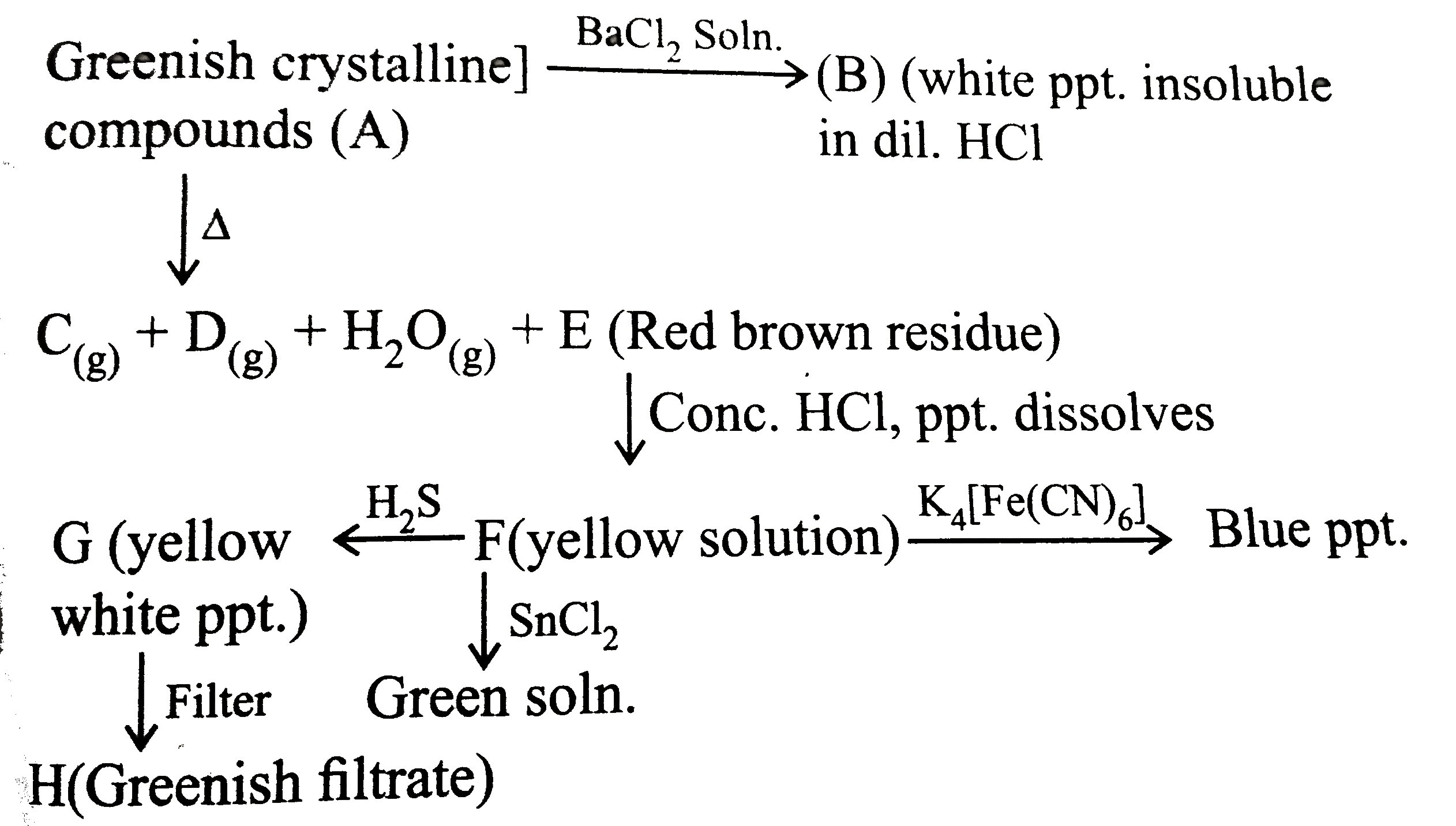
Identify compound AView Solution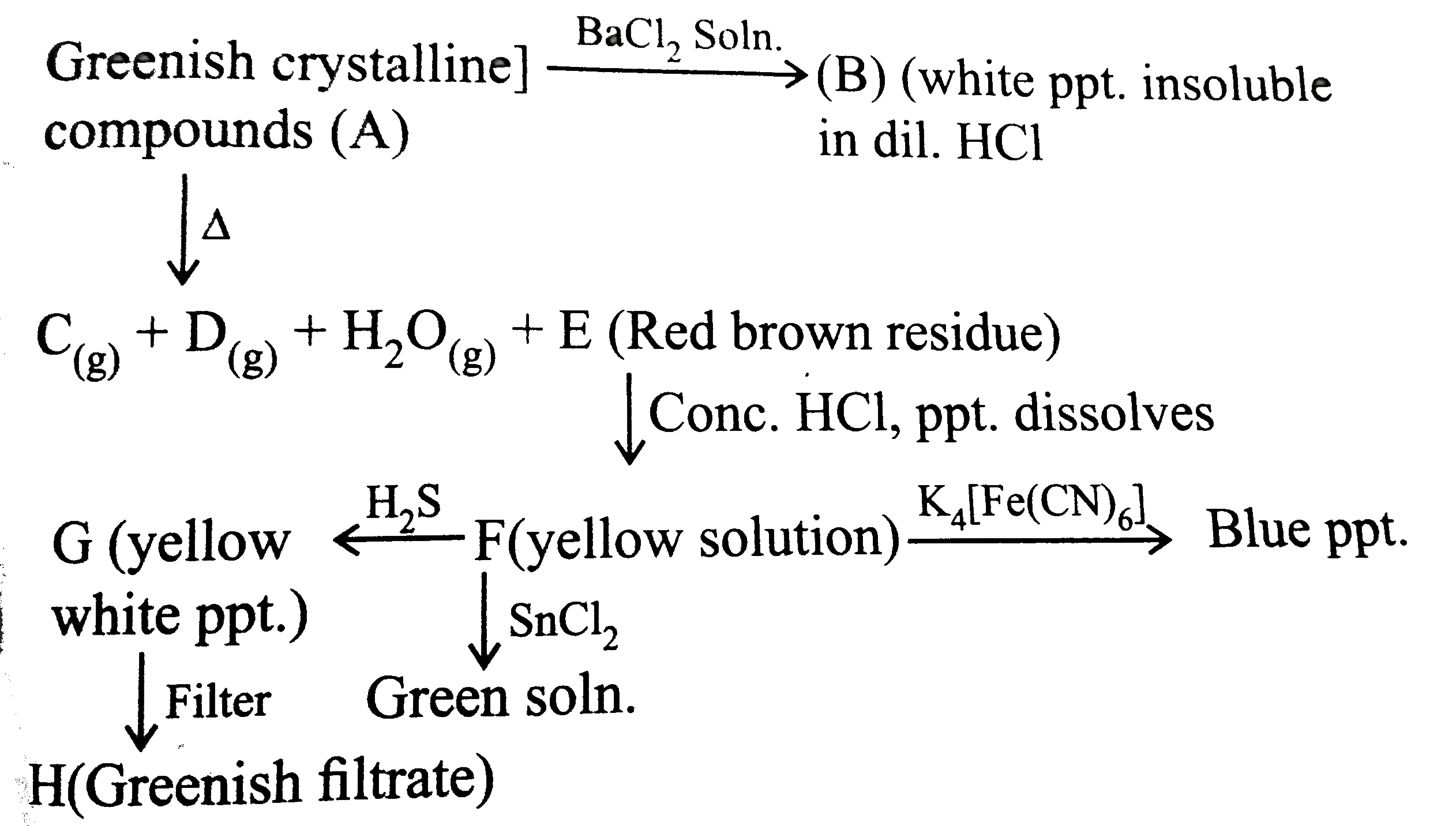
Gases C and D areView Solution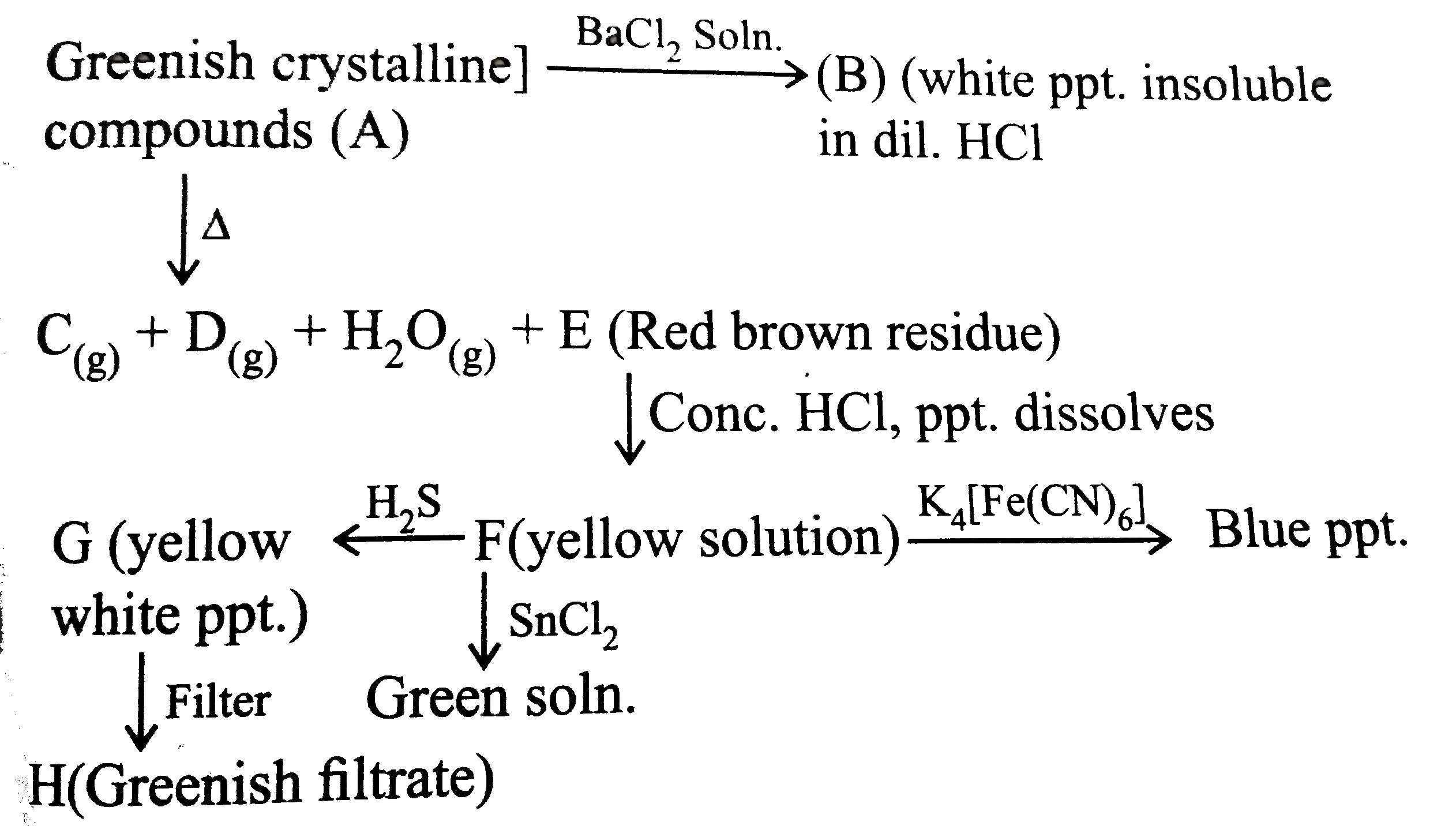
Identify yellow solution FView Solution
Identify GView Solution
Identify XView Solution
What is the formula of chocolate coloured ppt ?View Solution
What is the formula of brown ppt ?View Solution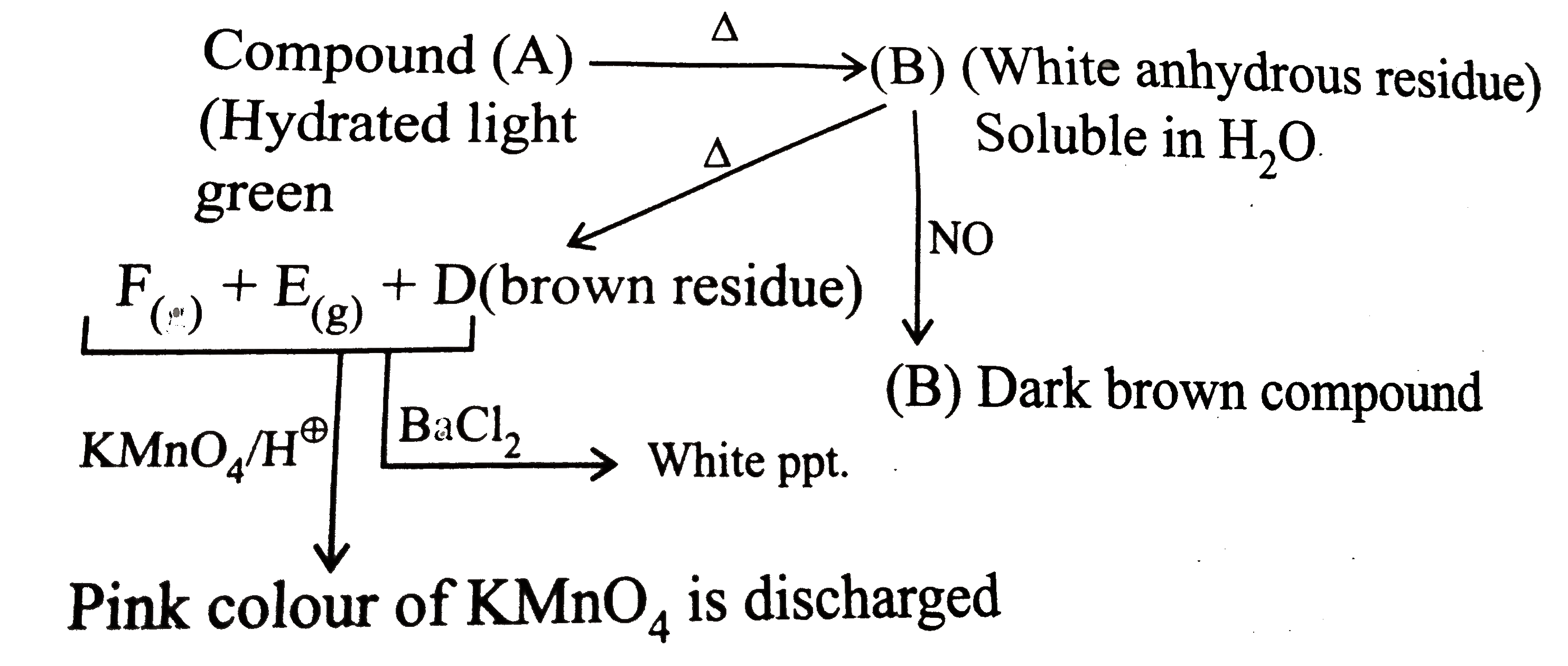
Identify CView Solution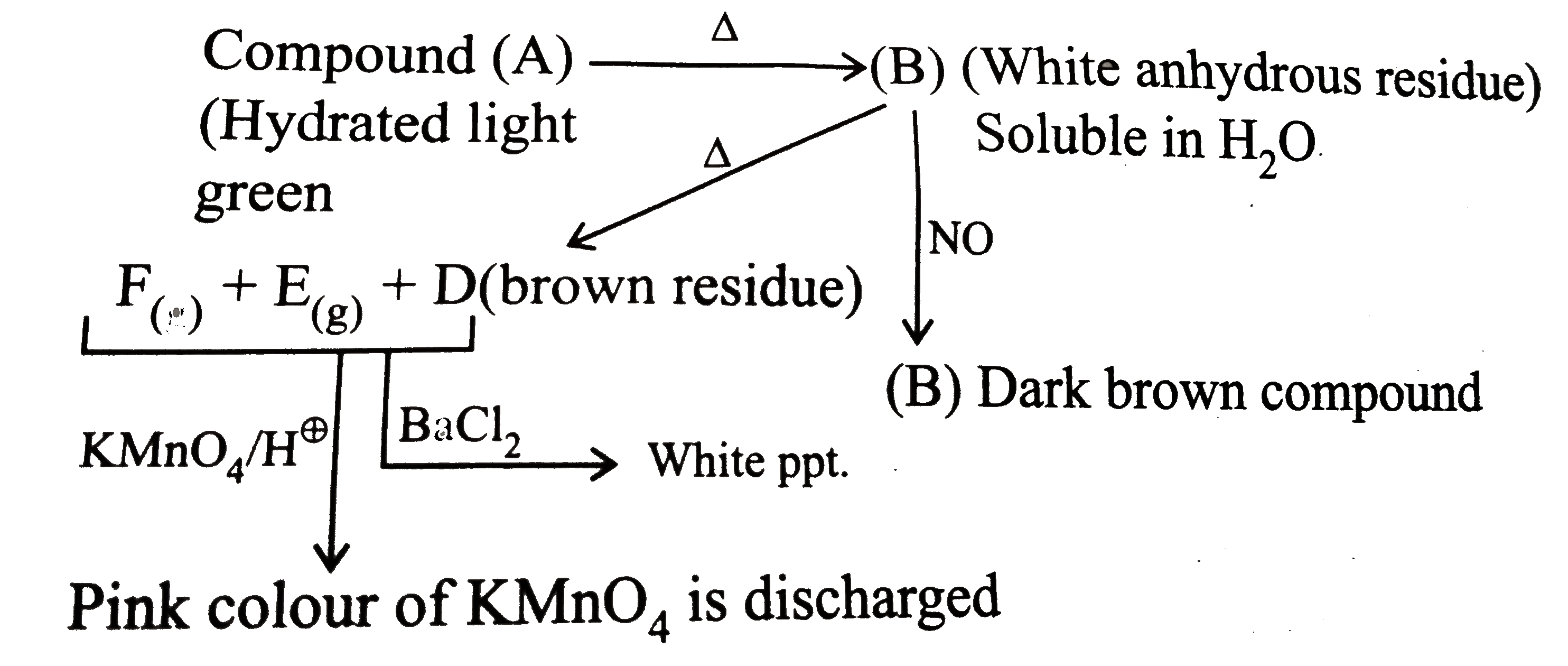
Identify BView Solution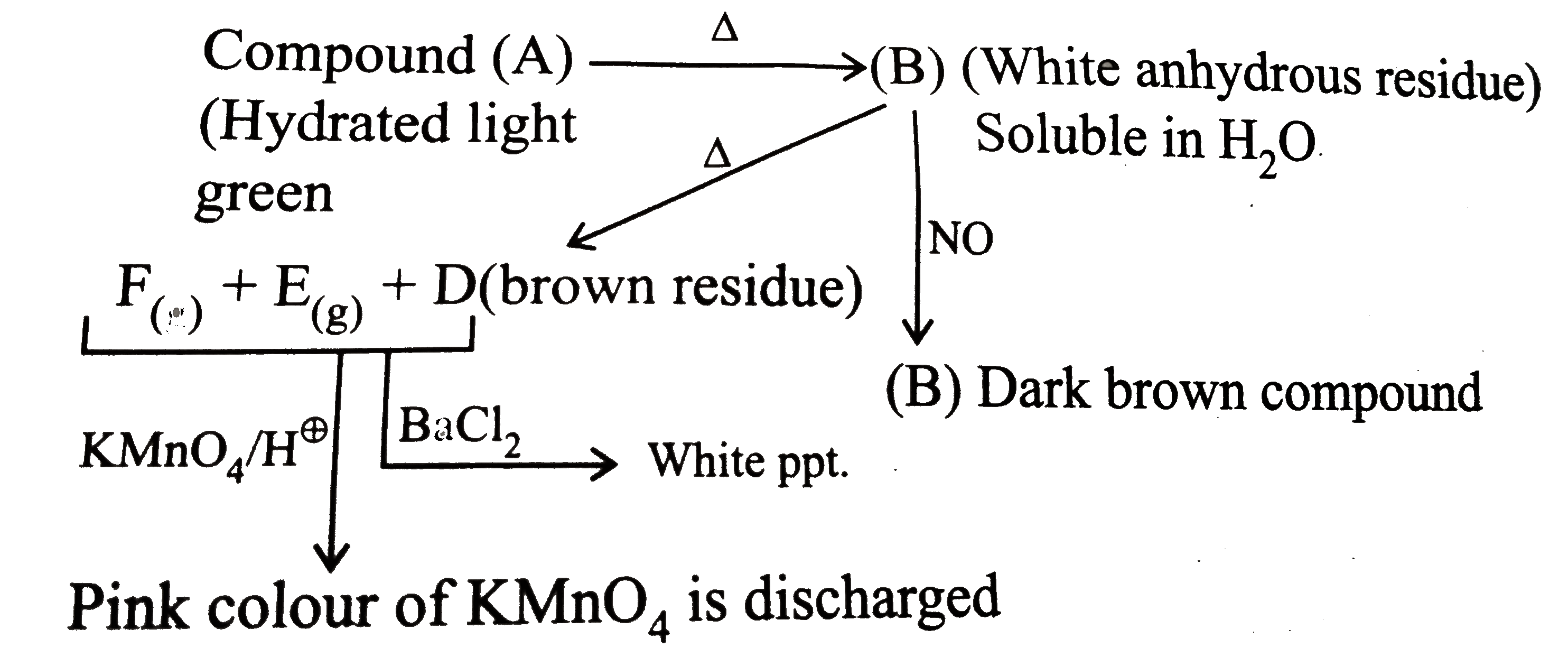
Identify DView Solution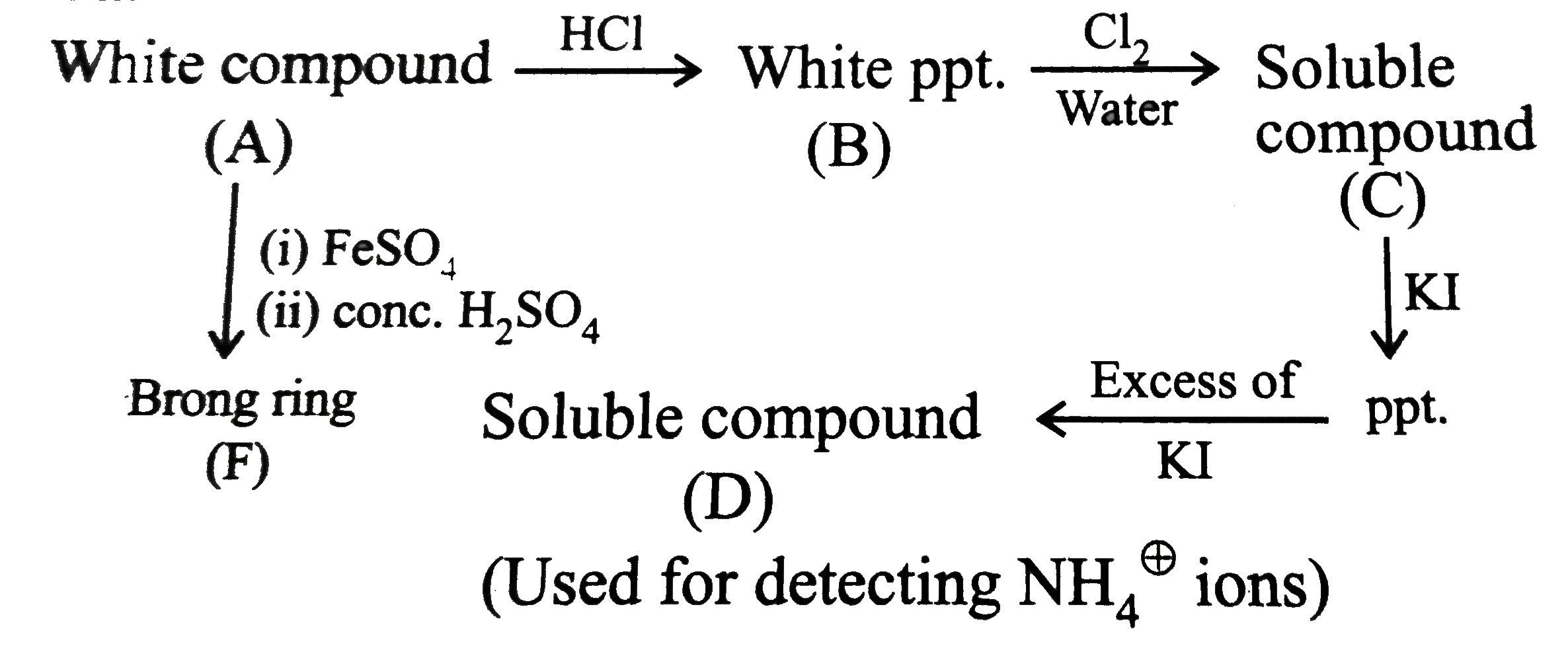
Compound (A) isView Solution
Oxidation state of Fe in compound (F) isView Solution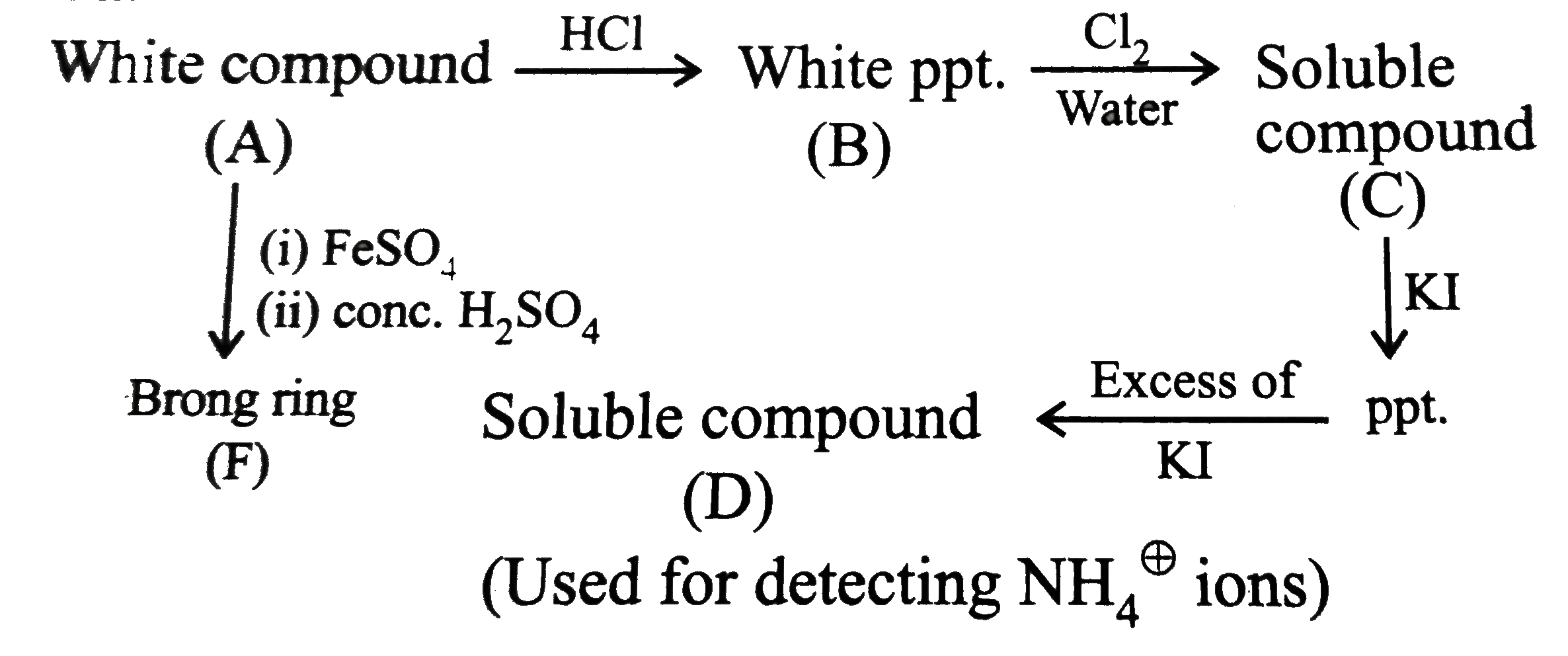
`underset("in basic medium")((D))+(NH_(4))_(2)SO_(4)rarr ` brown ppt (G)
Hence, compound(G) isView Solution
What ppt (B) `+ NH_(3) rarr` Black ppt . (H).
Hence, (H) is due to the formula ofView Solution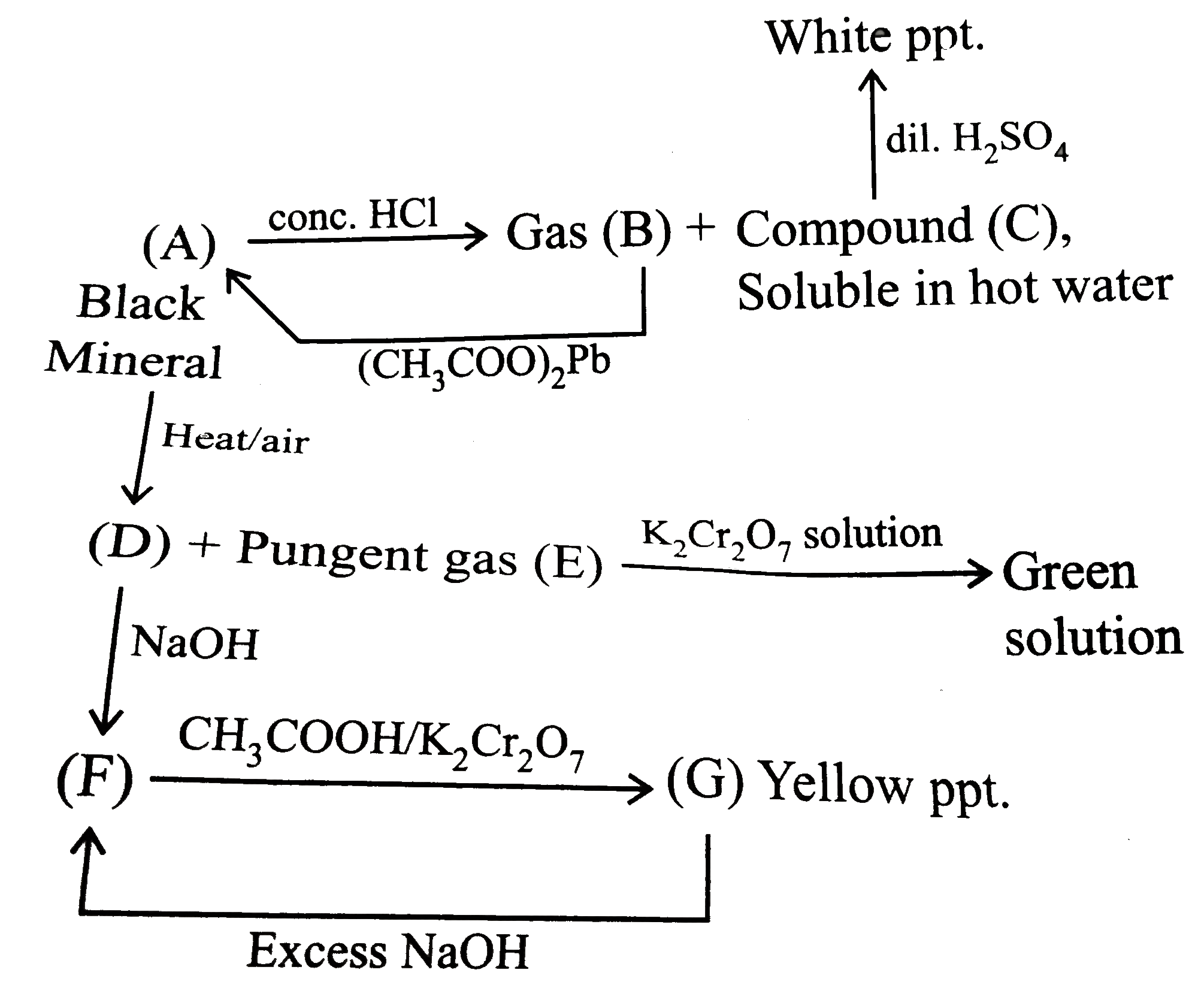
Gas (B) on passing through `CaSO_(4)` solution will giveView Solution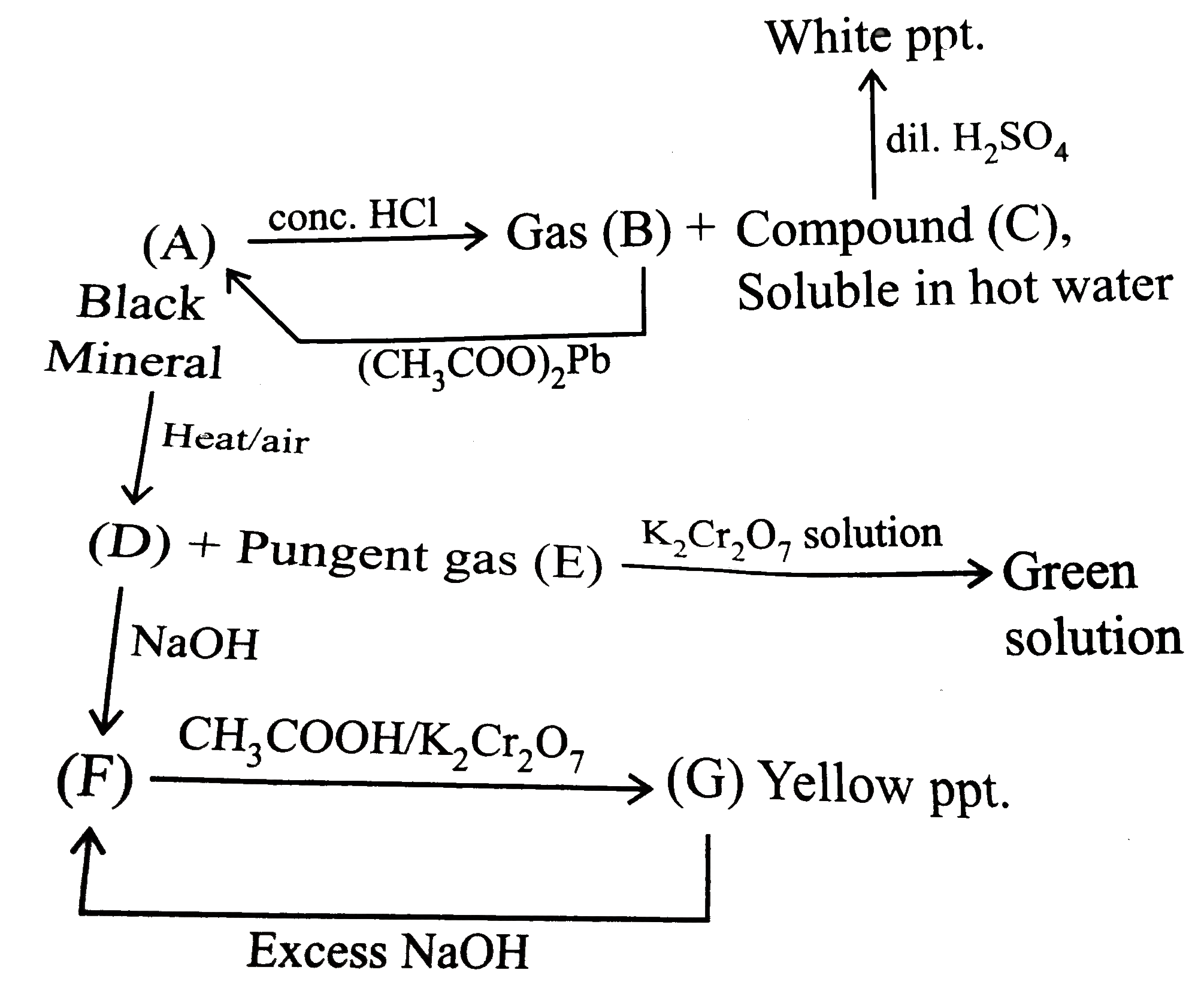
Compound (A),(B) and(E ) are respectivelyView Solution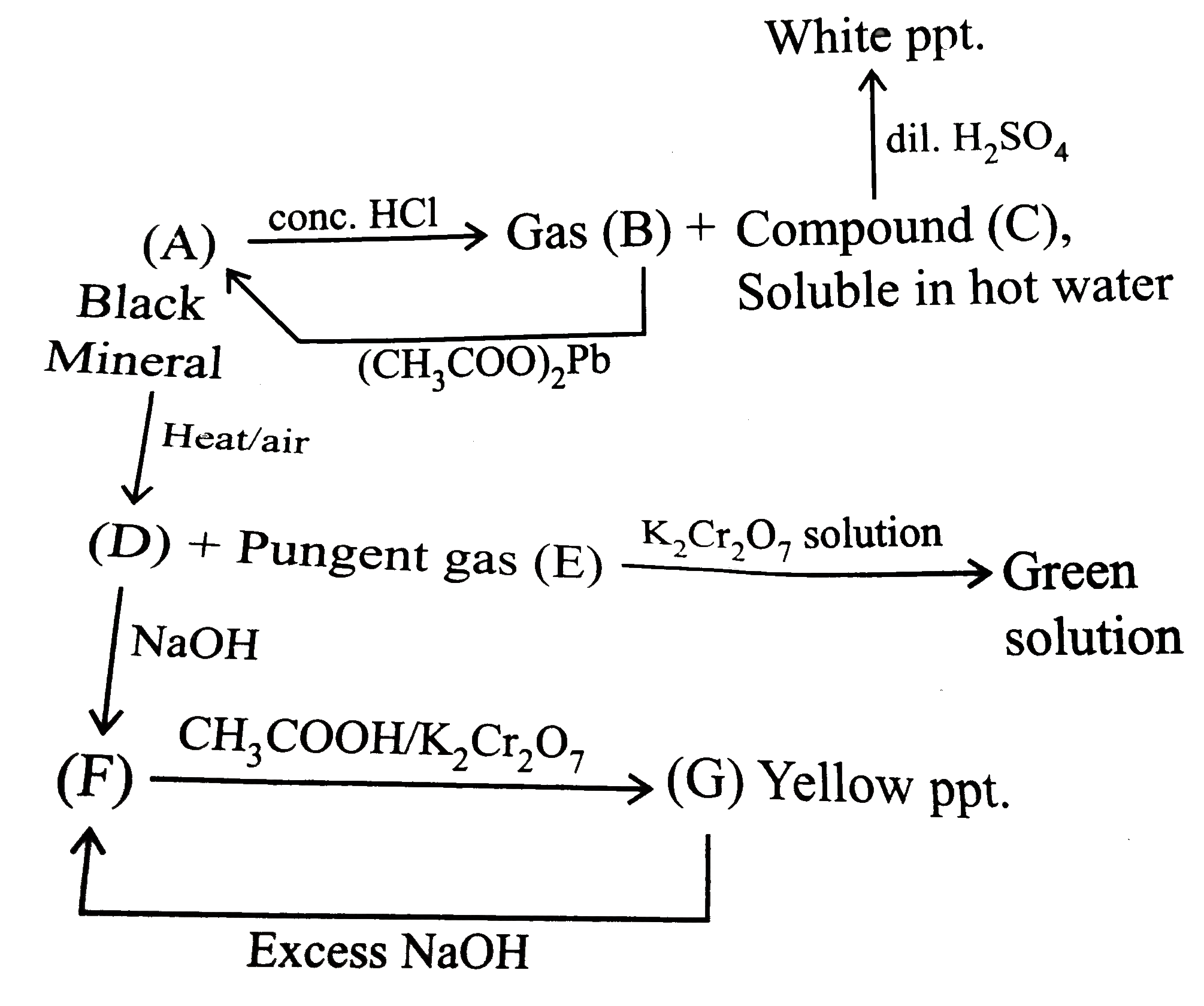
Compound (C ) and (D) rae respectivelyView Solutioni.(A)`underset(Delta)overset(NaOH)rarr(B)(g) overset(HCI)rarr` While fumes.
ii. After (B) is expelled completely, resultant alkline solution again gives gas (B) on heating with zine
iii.(A) `overset(Delta)rarr N_(2)O +H_(2)O`
Identify AView Solutioni.(A)`underset(Delta)overset(NaOH)rarr(B)(g) overset(HCI)rarr` While fumes.
ii. After (B) is expelled completely, resultant alkline solution again gives gas (B) on heating with zine
iii.(A) `overset(Delta)rarr N_(2)O +H_(2)O`
Identify BView Solutioni.(A)`underset(Delta)overset(NaOH)rarr(B)(g) overset(HCI)rarr` While fumes.
ii. After (B) is expelled completely, resultant alkline solution again gives gas (B) on heating with zine
iii.(A) `overset(Delta)rarr N_(2)O +H_(2)O`
What is the formula of white fumes?View Solution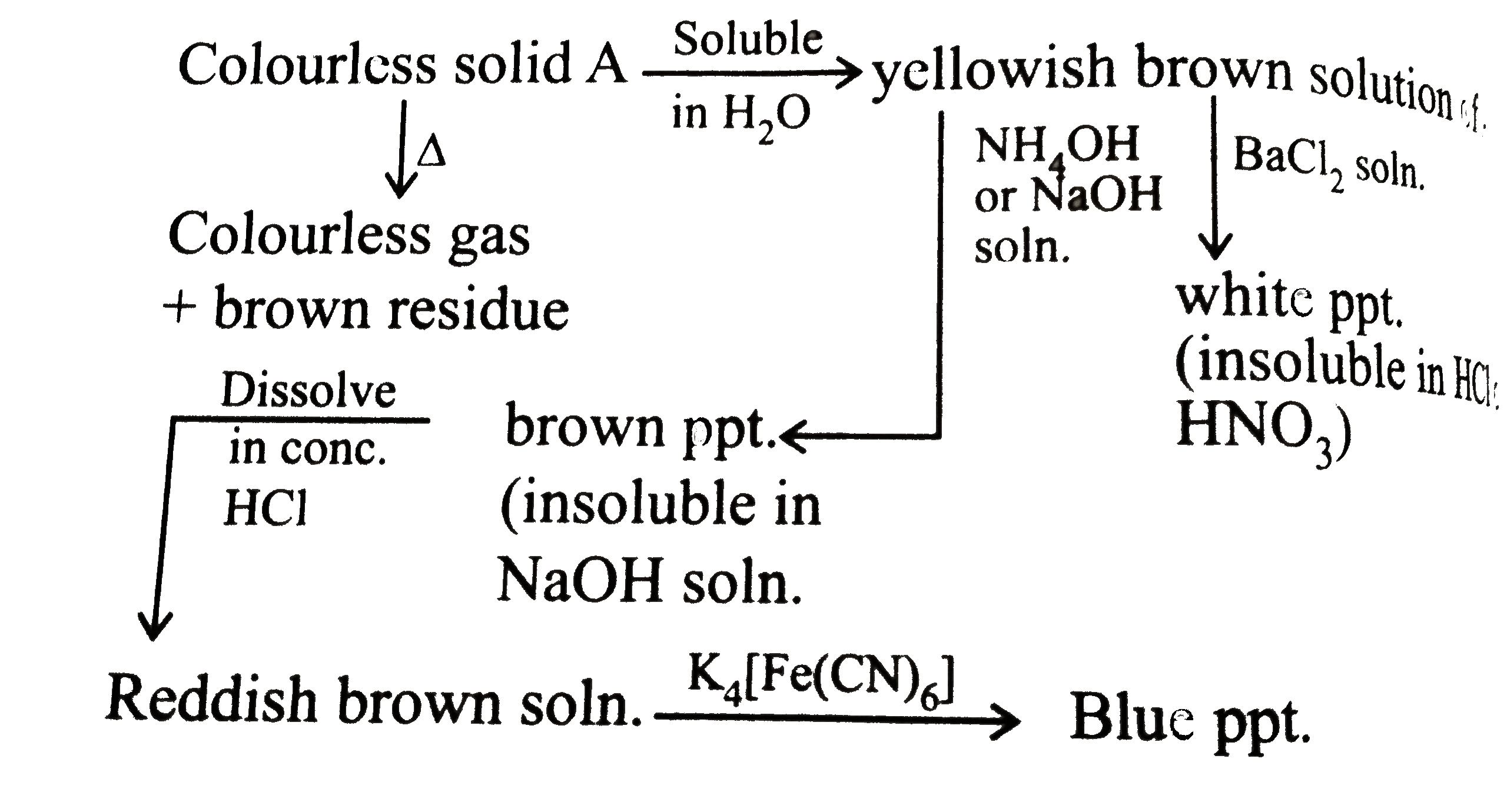
Identify AView Solution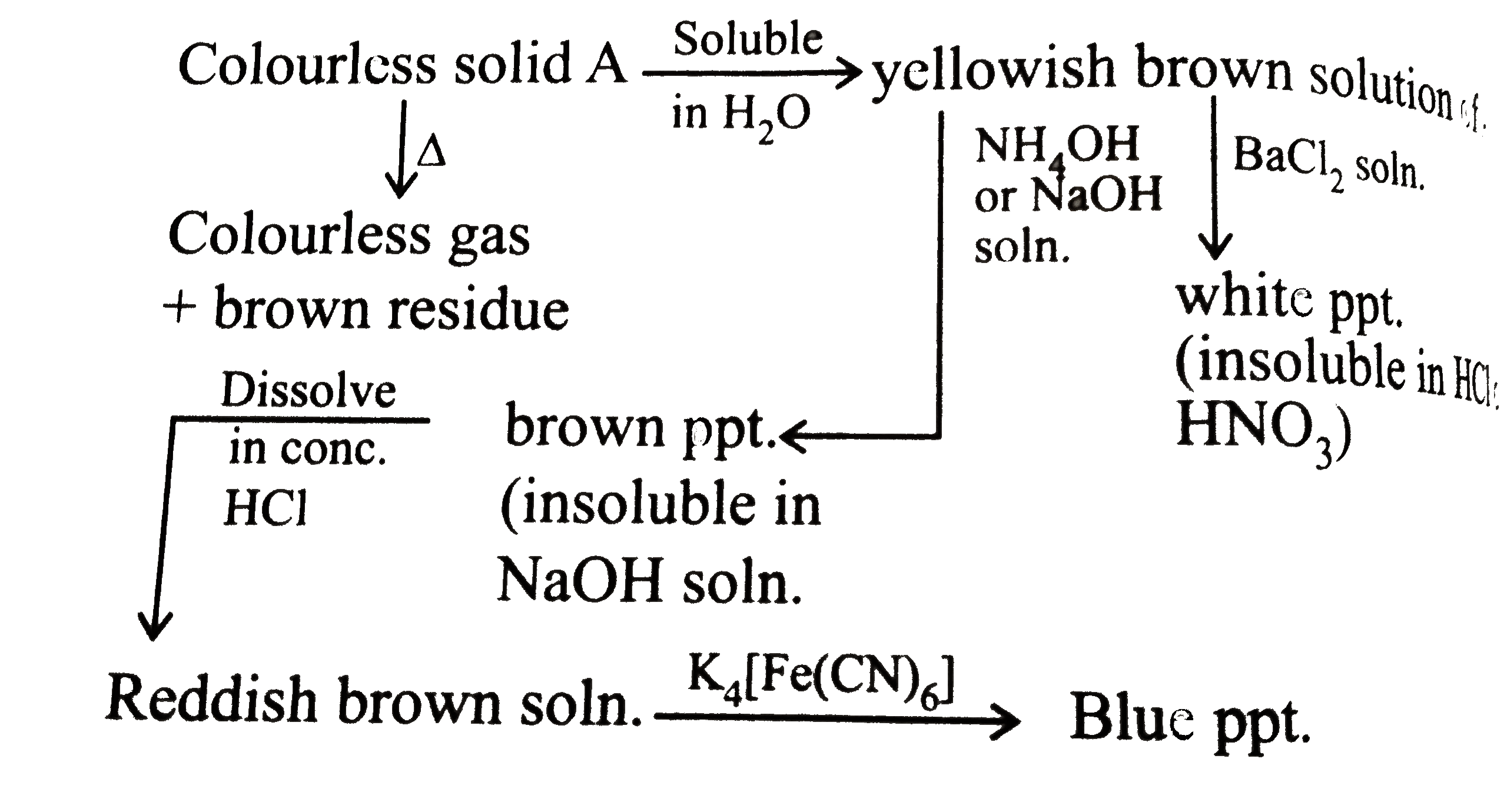
What is the formula of brown ppt?View Solution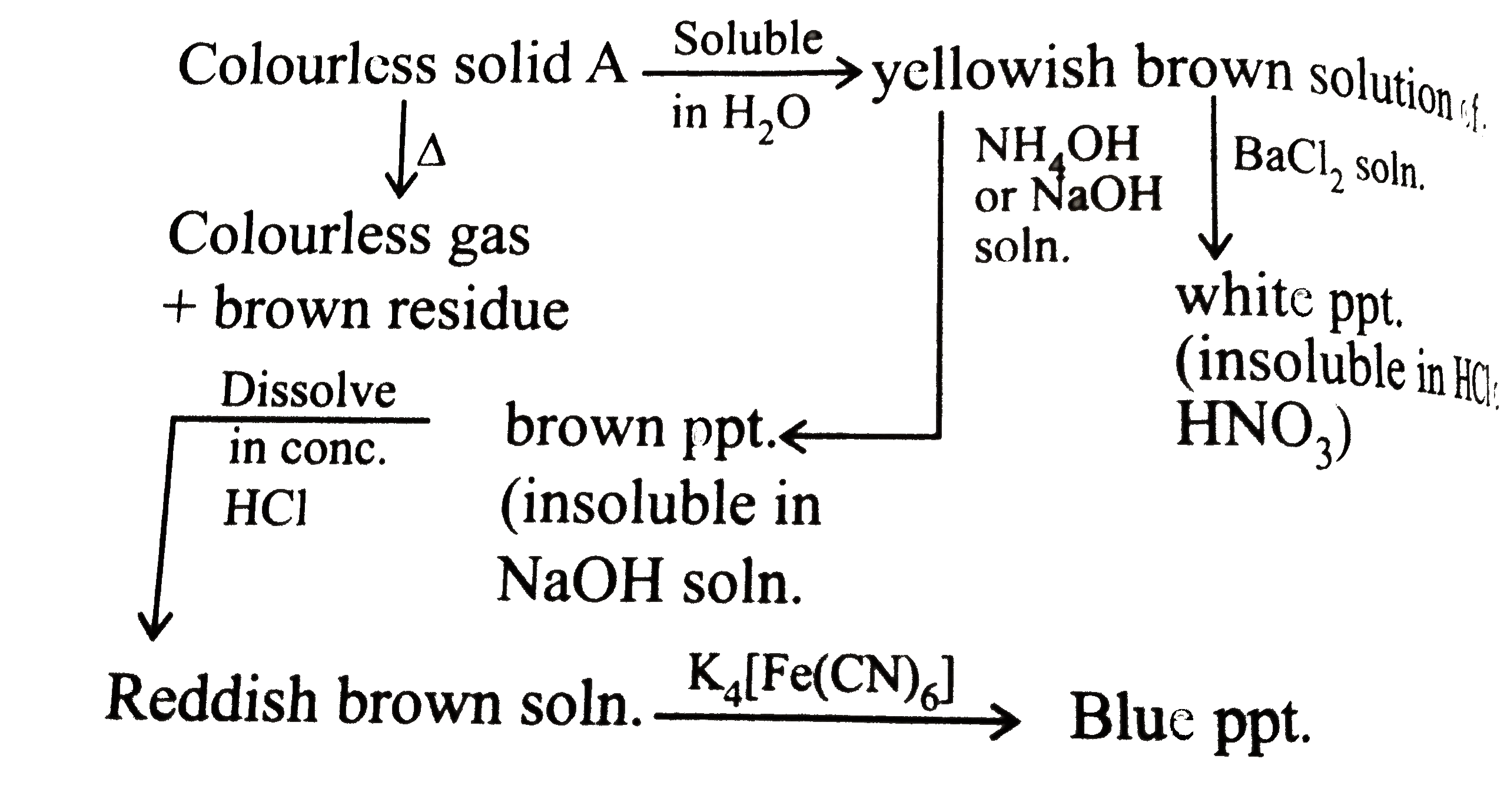
Which of the following complex is formed when A reacts with `K_(4)[Fe(CN)_(6)]`?View Solution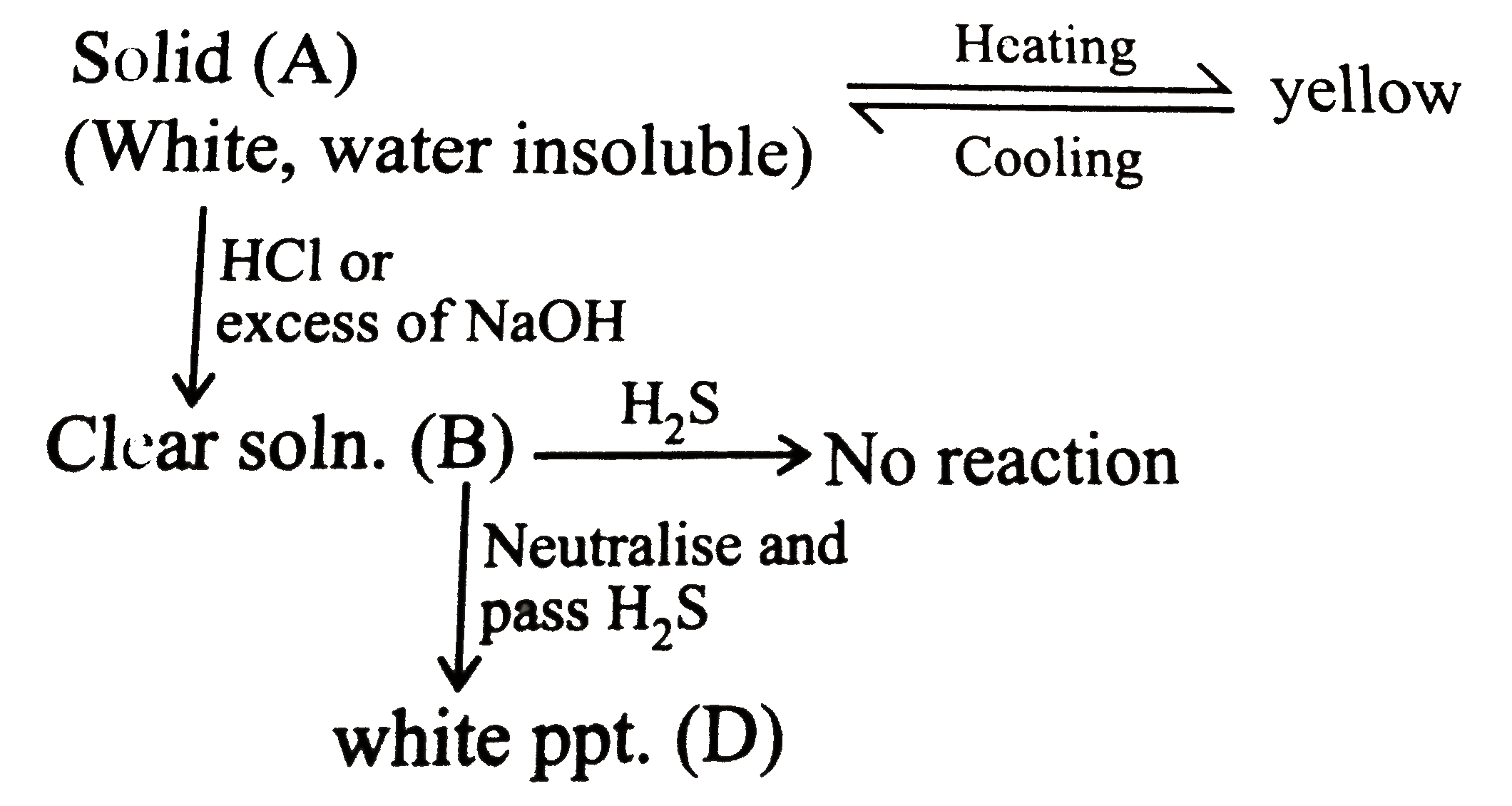
Identify AView Solution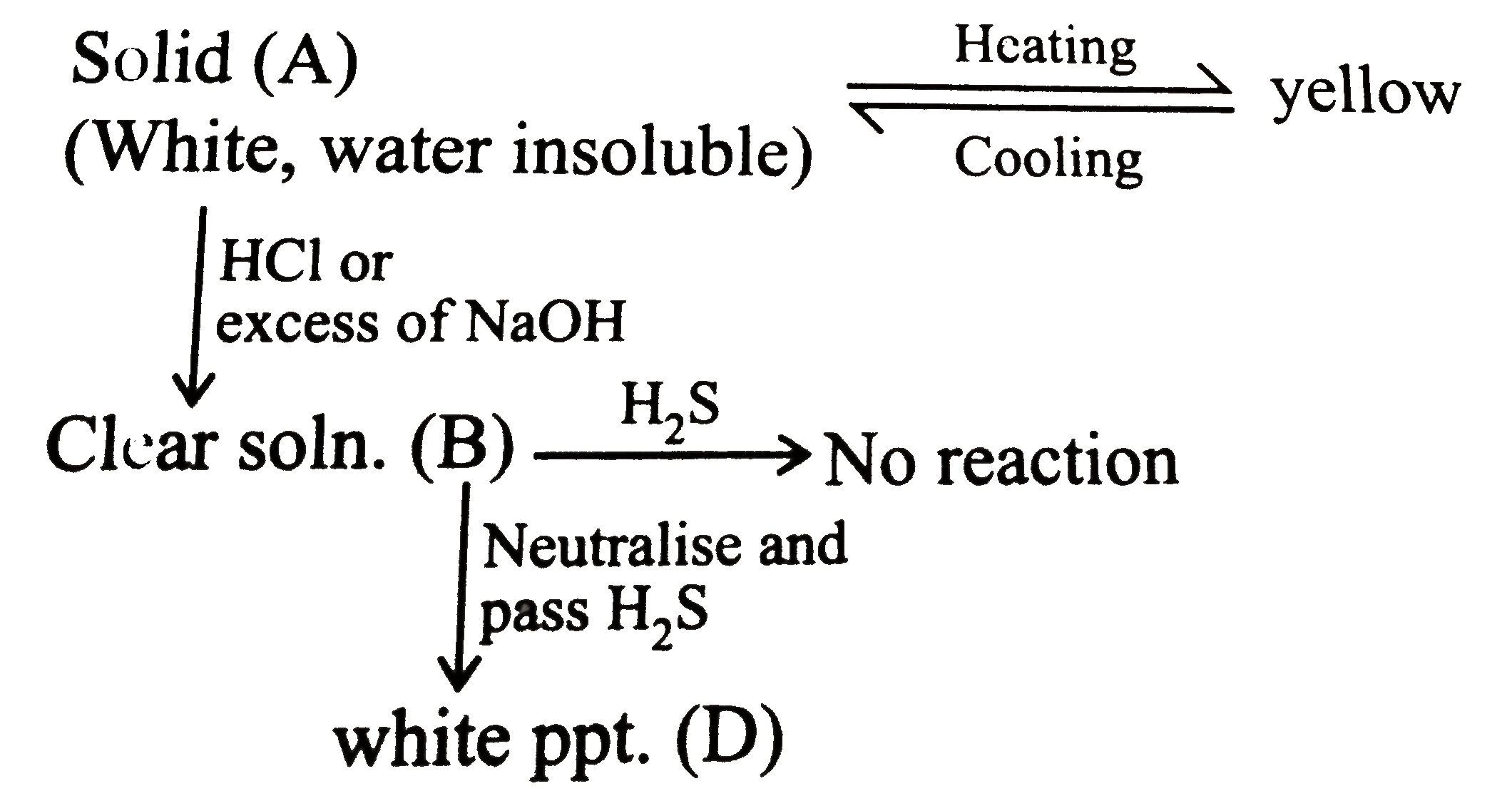
Identify BView Solution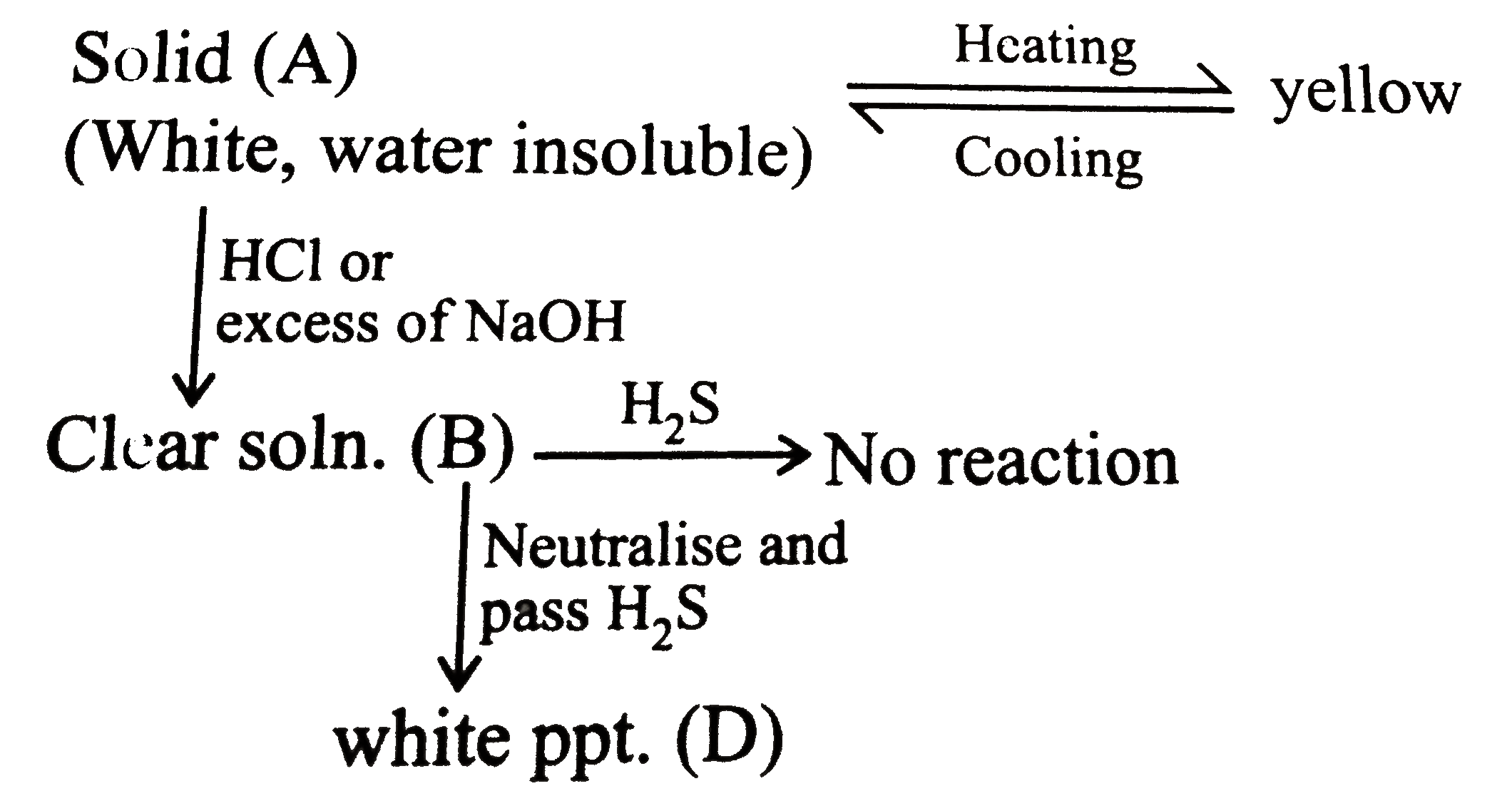
Identify CView Solution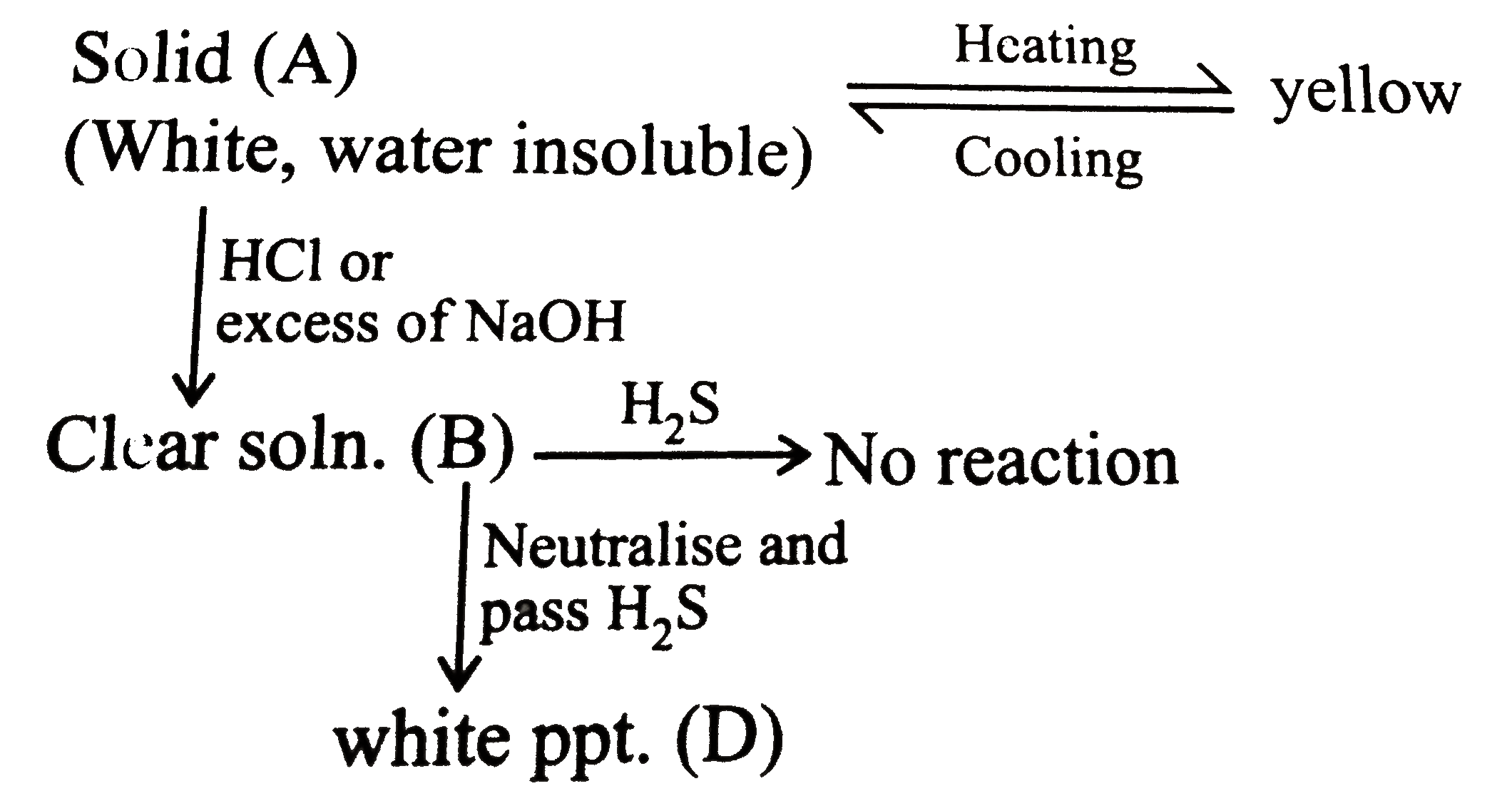
Identify DView Solution
Identify AView Solution
Identify BView Solution
Identify CView Solution
Identify DView Solution
Identify AView Solution
Identify BView Solution
Identify CView Solution
Identify DView Solutioni.(A) `overset(Delta)to ` glassy traparent beat (B) on platinum wire
(B) `+ CuSO_(4) rarr ` coloured bead(C )
ii `underset((D))((A))+conc. H_(2)SO_(4)+CH_(3)CH_(2)OH overset("ignite")rarr` green flame
iv.Aqueous solution (A) is alkline
Identify A .View Solutioni.(A) `overset(Delta)to ` glassy traparent beat (B) on platinum wire
(B) `+ CuSO_(4) rarr ` coloured bead(C )
ii `underset((D))((A))+conc. H_(2)SO_(4)+CH_(3)CH_(2)OH overset("ignite")rarr` green flame
iv.Aqueous solution (A) is alkline
Identify (B) .View Solutioni.(A) `overset(Delta)to ` glassy traparent beat (B) on platinum wire
(B) `+ CuSO_(4) rarr ` coloured bead(C )
ii `underset((D))((A))+conc. H_(2)SO_(4)+CH_(3)CH_(2)OH overset("ignite")rarr` green flame
iv.Aqueous solution (A) is alkline
Identify AC.View Solutioni.(A) `overset(Delta)to ` glassy traparent beat (B) on platinum wire
(B) `+ CuSO_(4) rarr ` coloured bead(C )
ii `underset((D))((A))+conc. H_(2)SO_(4)+CH_(3)CH_(2)OH overset("ignite")rarr` green flame
iv.Aqueous solution (A) is alkline
Identify D.View SolutionA colourless mixture of two salts (A) and (B) [excess] is soluble in `H_(2)O`.
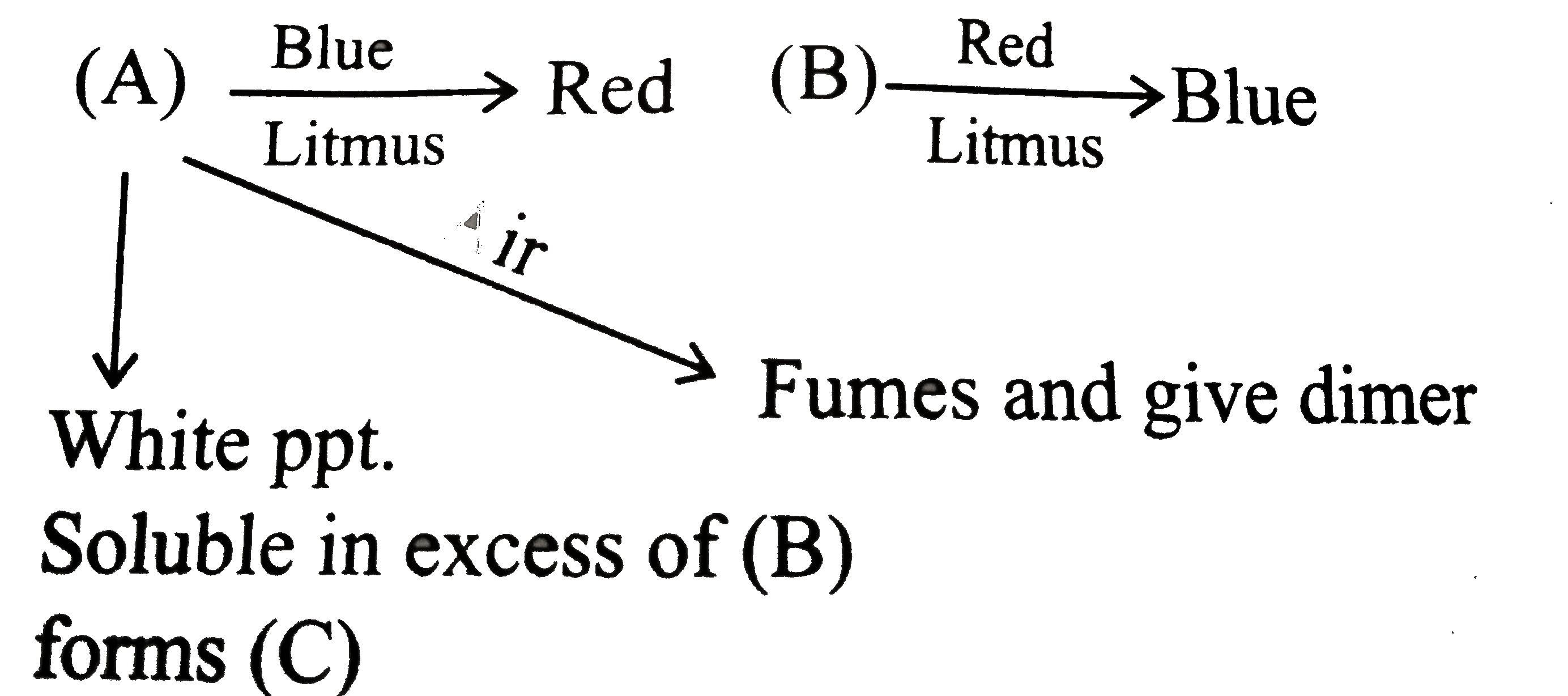
Identify AView SolutionA colourless mixture of two salts (A) and (B) [excess] is soluble in `H_(2)O`.
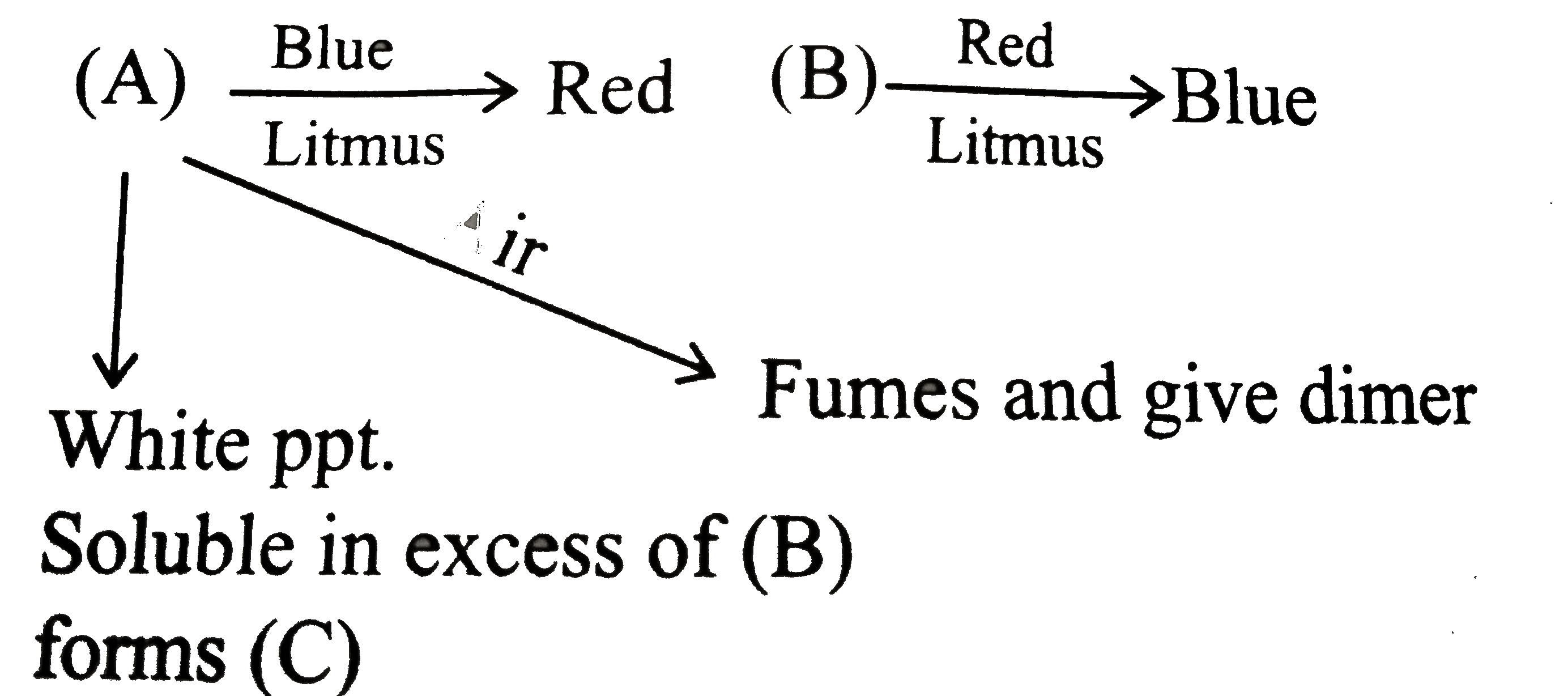
Identify BView SolutionA colourless mixture of two salts (A) and (B) [excess] is soluble in `H_(2)O`.
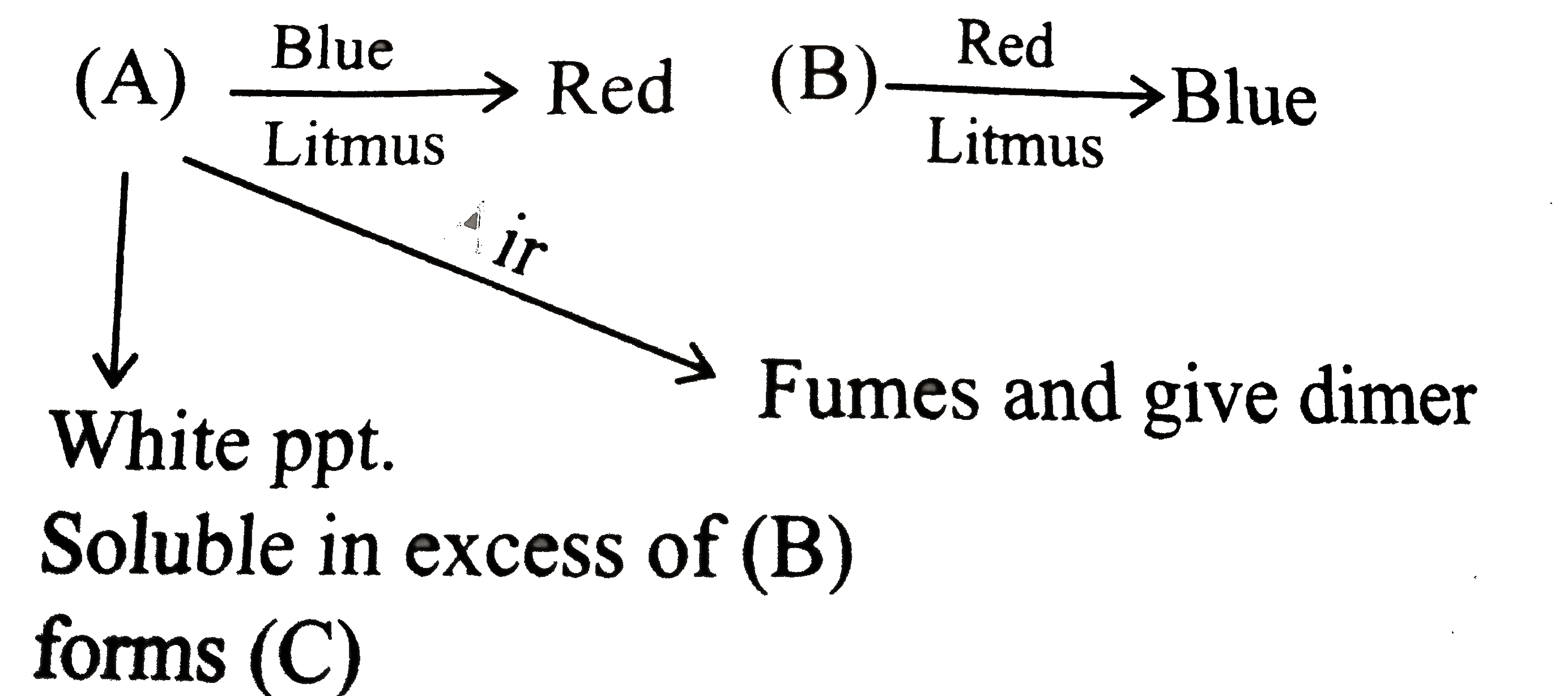
Identify CView Solution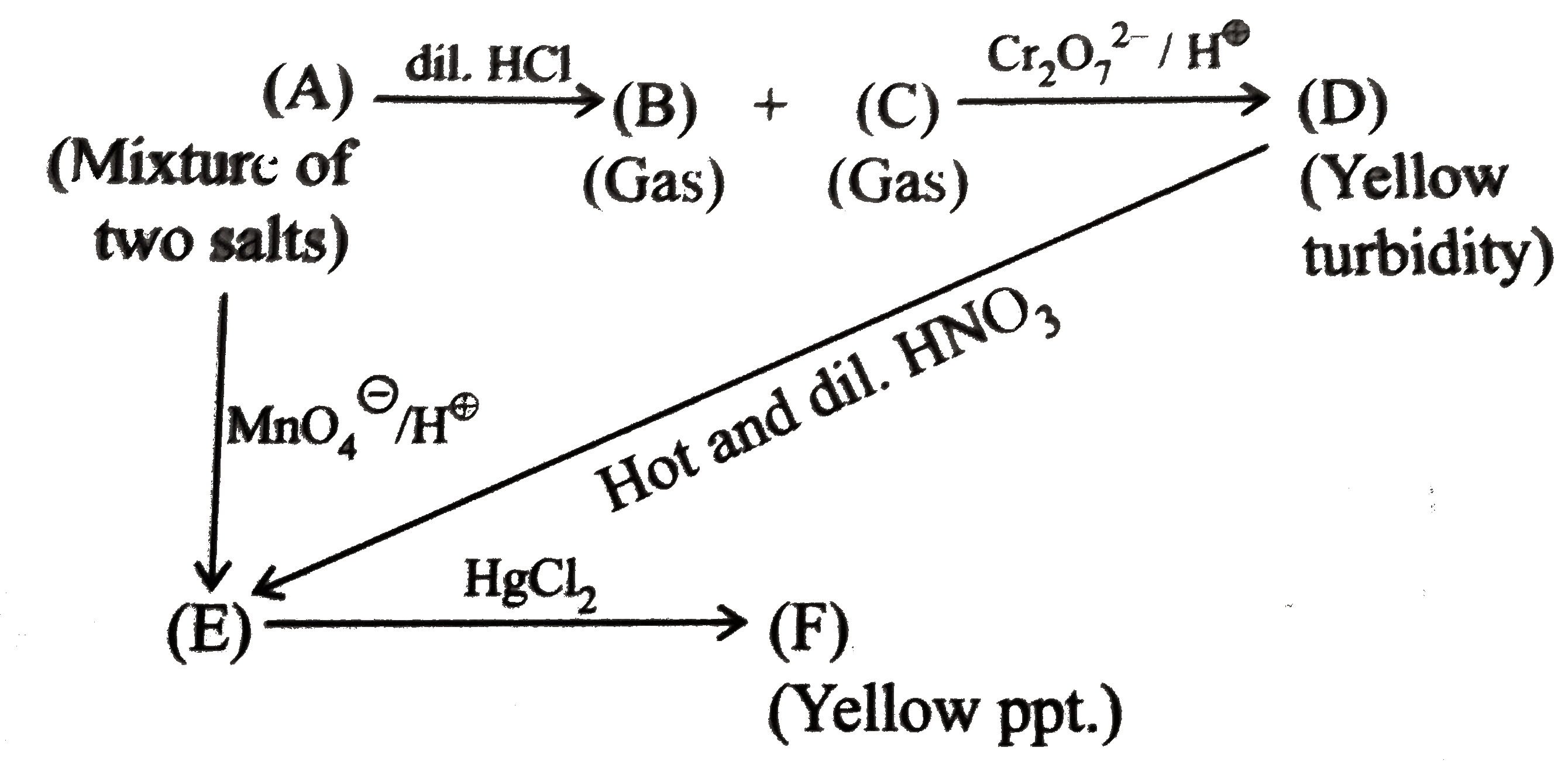
Find the anion (s)View Solution
Find out (E )View Solution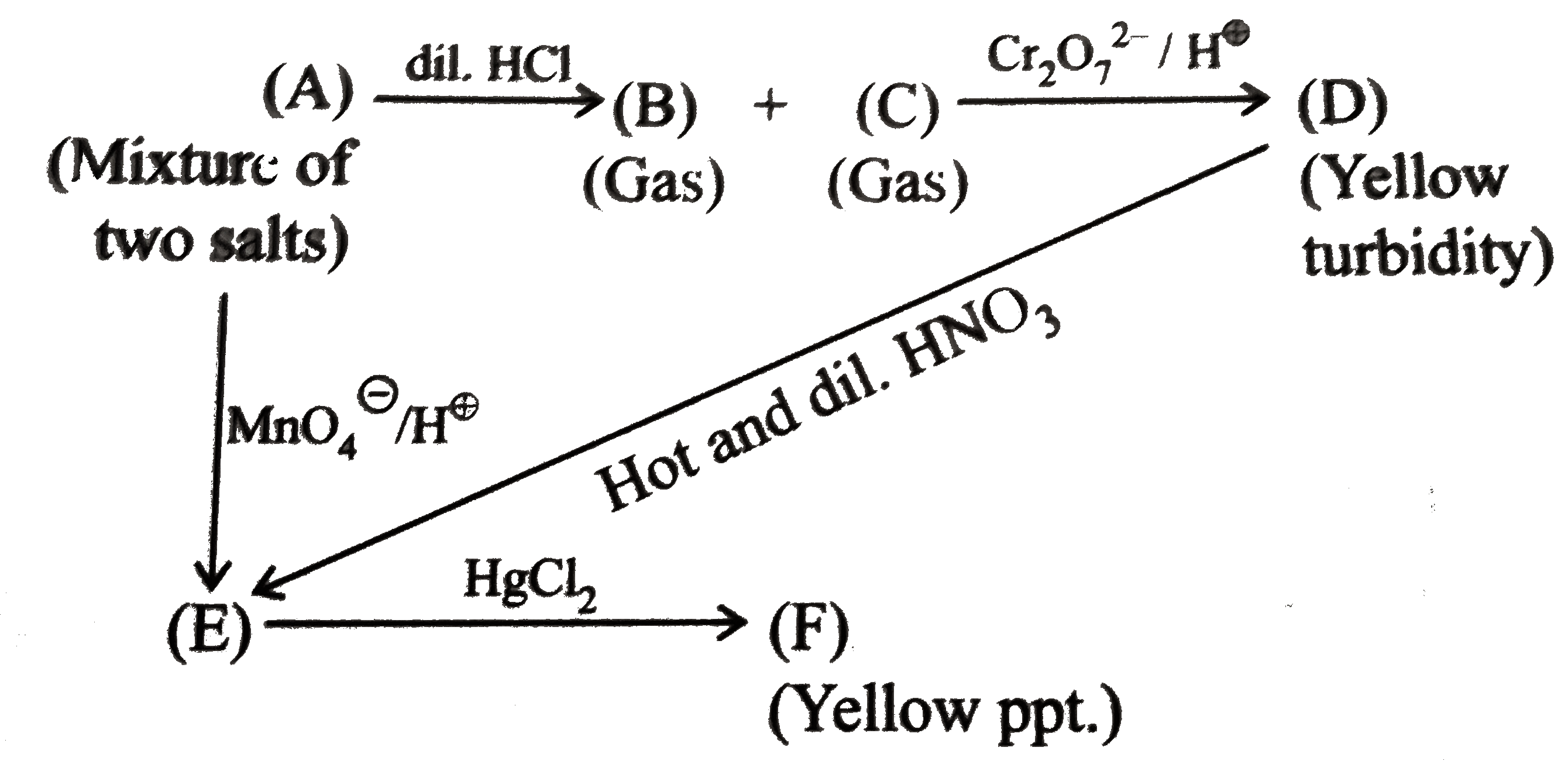
Find out (F)View SolutionCations are classified into varius group on the basis of their behaviour against some reagents .The group reagent used for the classifaction of most common cation are `HCI,H_(2)S,NH_(4)OH,(NH_(4))_(2)CO_(3)`. Classification is based on whether a cation reacts with these reagents by the formation of precipitates or not .
Which one among the following paires of ions cannot be separated by `H_(2)S` in the presence of dilute hydrochloric acid ?View SolutionCations are classified into varius group on the basis of their behaviour against some reagents .The group reagent used for the classifaction of most common cation are `HCI,H_(2)S,NH_(4)OH,(NH_(4))_(2)CO_(3)` Classification is based on whether a cation reacts with these reagents by the formation of precipitates or not .
An aqueous solution contain `Hg^(2+),Hg_(2)^(2+),Pb^(2+)`.THe addition of `2M HCI` will procipitate.View SolutionCations are classified into varius group on the basis of their behaviour against some reagents .The group reagent used for the classifaction of most common cation are `HCI,H_(2)S,NH_(4)OH,(NH_(4))_(2)CO_(3)`. Classification is based on whether a cation reacts with these reagents by the formation of precipitates or not .
An aqucous solution which is sightly acids contains cattions `Fe^(2+),Zn^(2+) and Cu^(2+)`. THe rengent added in excess to this solution would identify the separate `Fe^(2+)` ion in one step isView SolutionThe reagents like `AgNO_(3),K_(4)[Fe(CN)_(6)],KCNS,KI,K_(2)CrO_(4)` Nessler's ect, find extenstive and very important applicasion in quentitative analysis because these resgents form different type of produce with different cation for axample `KI` form yellow precipitate with `Pb^(2+)` but at form red iprecipitate with `Hg^(2+)` , Hence these reagents are widely used in the quantitative amalysis of morgenic salts
Which of the following is not currectly matched ?View SolutionThe reagents like `AgNO_(3),K_(4)[fe(CN)_(6)],KCNS,KI,K_(2)CrO_(4)` Nessler's ect, find extenstive and very important applicasion in quentitative analysis because these resgents form different type of produce with different cation for axample `KI` form yellow precipitate with `Pb^(2+)` but at form red iprecipitate with `Hg^(2+)` , Hence these reagents are widely used in the quantitative amalysis of morgenic salts
Which of the following cation (i.e. basic radicals) forms coloured (not white) percipitates with aqueous solution of potassium indide the precipitete does not dissolve is exiess og reagent?View SolutionThe reagents like `AgNO_(3),K_(4)[Fe(CN)_(6)],KCNS,KI,K_(2)CrO_(4)` Nessler's ect, find extenstive and very important applicasion in quentitative analysis because these resgents form different type of produce with different cation for axample `KI` form yellow precipitate with `Pb^(2+)` but at form red iprecipitate with `Hg^(2+)` , Hence these reagents are widely used in the quantitative amalysis of morgenic salts
Which of the following hydroxide does not dissolve in ammounts solution but sisolves in sodium hydroxide ?View Solution`NH_(3)` solution was added to four semple solution in difference test tube and found the following observation about the precipitate.
a. White ppt which is solution in oxcess of `NH_(3)` solution
b.On heating which is white in cold but yellow on heating
c. The cation present in (b) forms white ppt , with hypo solution which give black ppt on heating
d. The cation present in (c ) forms soluble complex with excess of `NH_(3)` solution
White ppts in (a),(b) and (c ) respectively obtained areView Solution`NH_(3)` solution was added to four semple solution in difference test tube and found the following observation about the precipitate.
a. White ppt which is solution in oxcess of `NH_(3)` solution
b. On heating which is white in cold but yellow on heating
c. The cation present in (b) forms white ppt , with hypo solution which give black ppt on heating
d. The cation present in (c ) forms soluble complex with excess of `NH_(3)` solution
The solution initialy present in (a) `+ H_(2)S` (basic medium) gives ppt , then (a) may haveView Solution`NH_(3)` solution was added to four semple solution in difference test tube and found the following observation about the precipitate.
a. White ppt which is solution in oxcess of `NH_(3)` solution
b.On heating which is white in cold but yellow on heating
c. The cation present in (b) forms white ppt , with hypo solution which give black ppt on heating
d. The cation present in (c ) forms soluble complex with excess of `NH_(3)` solution
White ppt in (c) and the soluble complex from white ppt with the type solution is//areView Solution(A) is a colourless solid, it metal when heated and gives of a gas (B) Which is supporter of combustion , if heating is contimed the white of the solid disuppears , When (A) is heatyed with an aqueous `NaOH` solution , an alkaline gas (C ) is evolved ,When gas(B) is leasted with sodumine ,a colourless solid (D) is formed .When (D) is heated with dil `H_(2)SO_(4)` a colourless liquid (F) is formed
The compound E hasView Solution(A) is a colourless solid, it metal when heated and gives of a gas (B) Which is supporter of combustion , if heating is contimed the white of the solid disuppears , When (A) is heatyed with an aqueous `NaOH` solution , an alkaline gas (C ) is evolved ,When gas(B) is leasted with sodumine ,a colourless solid (D) is formed .When (D) is heated with dil `H_(2)SO_(4)` a colourless liquid (F) is formed .
The mass of compound E isView Solution(A) is a colourless solid, it metal when heated and gives of a gas (B) Which is supporter of combustion , if heating is contimed the white of the solid disuppears , When (A) is heatyed with an aqueous `NaOH` solution , an alkaline gas (C ) is evolved ,When gas(B) is leasted with sodumine ,a colourless solid (D) is formed .When (D) is heated with dil `H_(2)SO_(4)` a colourless liquid (F) is formed .
The compound C hasView Solution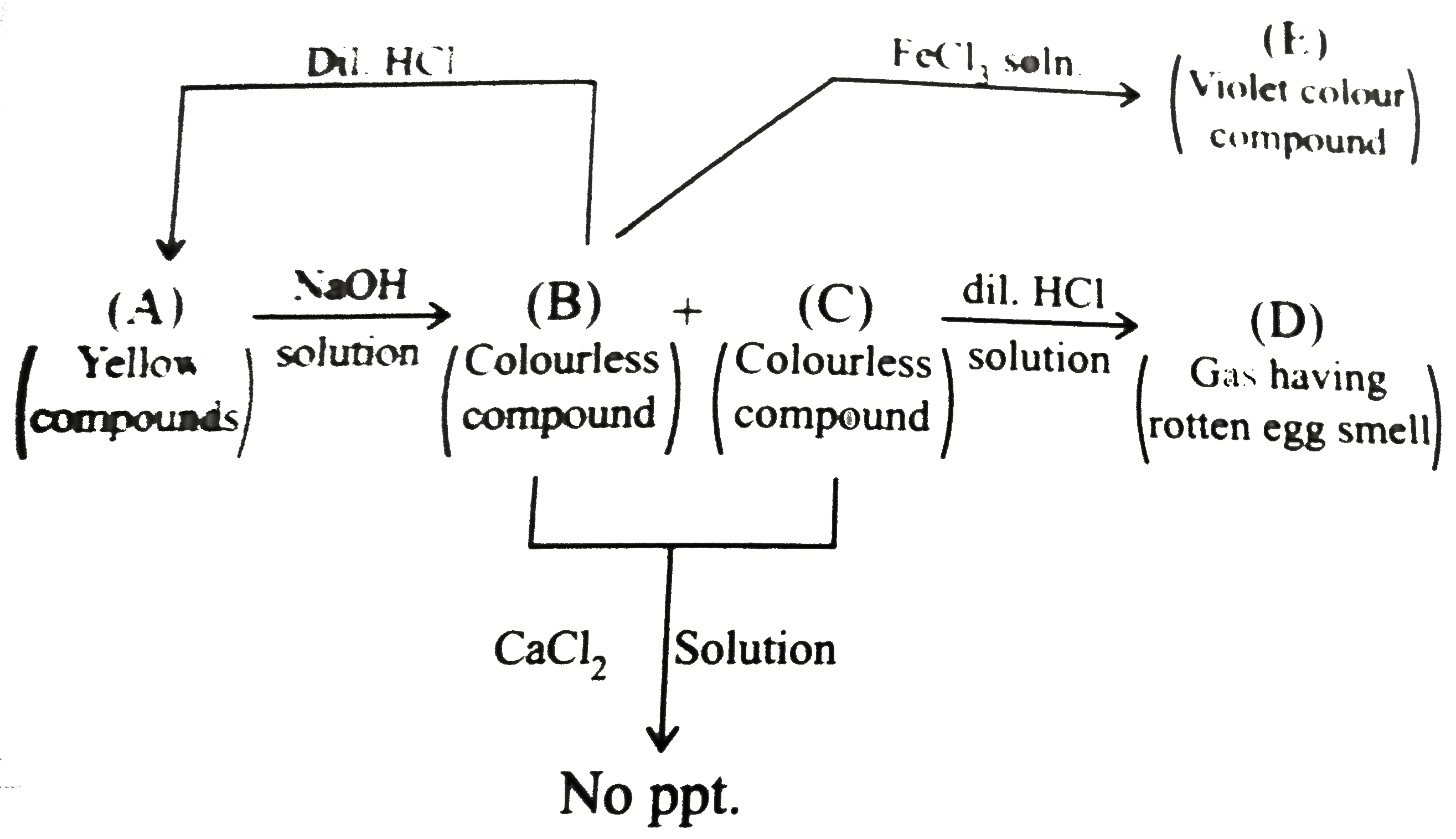
compound (B) on strong heating produces compound(s) which has/haveView Solution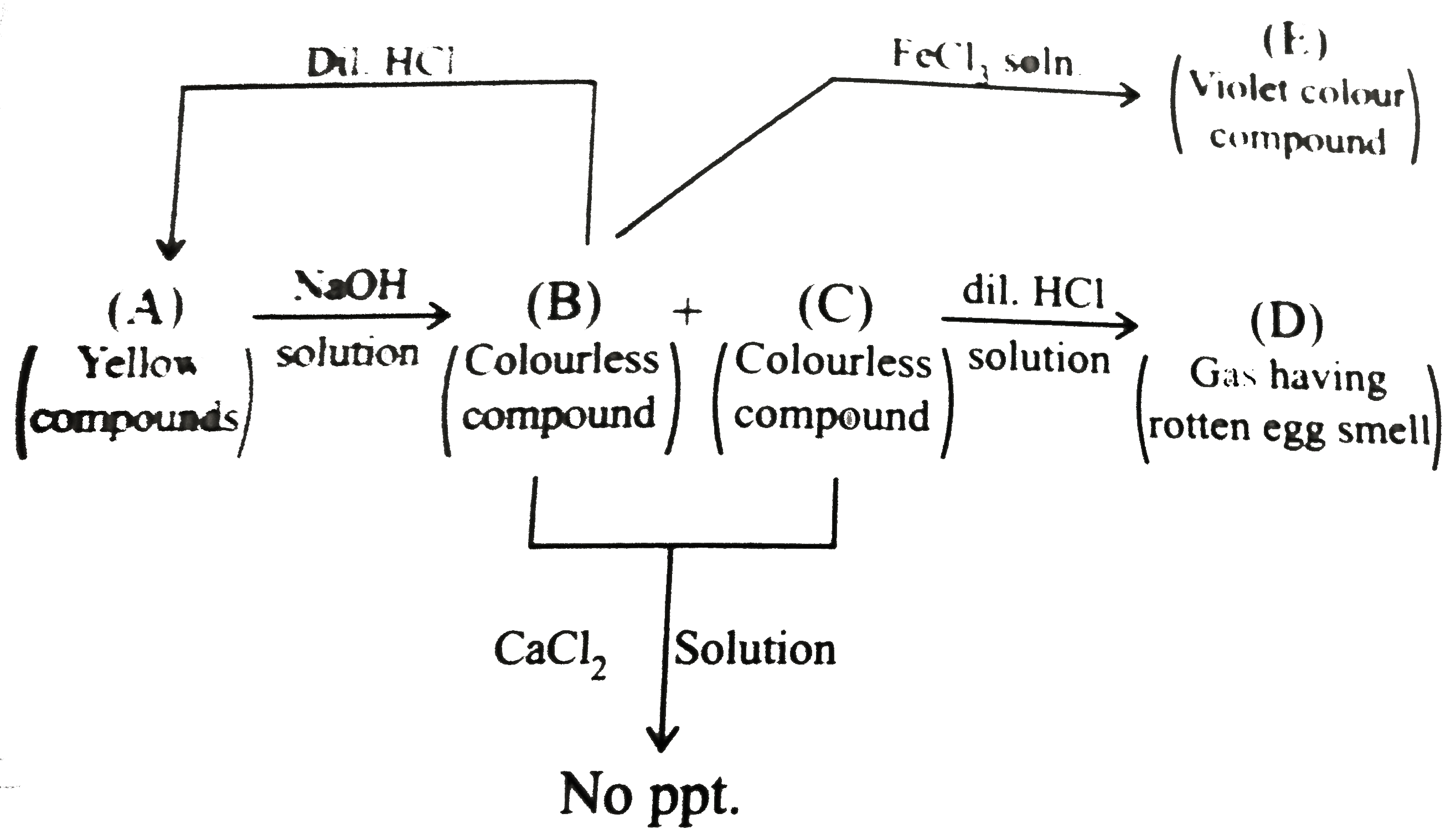
Which of the following statement is/are correct for gas (D) ?
(I)it has the state of hydridisation `sp^(3)`
(II)Gas can be identified by `CaCI_(2)` solution
(III)Gas can be identified by `Pb(OAc)_(2)` solution
(IV)Gas can be identified by passing through solutionView Solution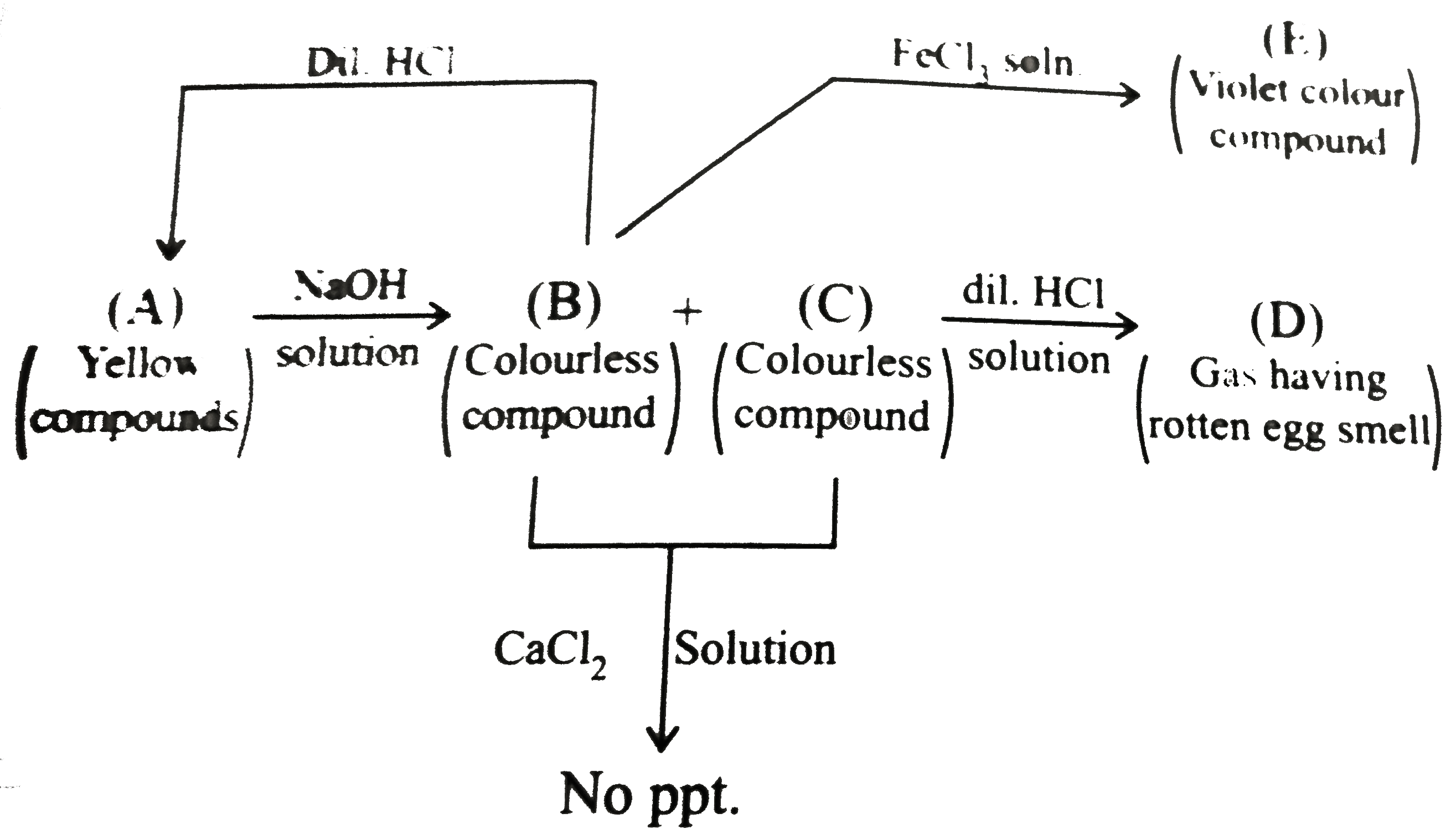
Compound (B) on reaction with `[Na(en)_(3)][NO_(3))_(2)` gives a coloured complex exhibilityView SolutionA colourless (A) when place into water a heavy white turbidly of (B) solid (A) gives a close solution in conesolution in cone `HCI` when `HCI` solution is added to clear solution water ,(B) forms again (B) dissolves in dilute `HCI`. When `H_(2)S` is passed through a sespension of (A) or (B), a black precipitate (C ) forms , (C ) is insolves in yellow ammonium sulphide `(NH_(4))_(2)S` , cone `H_(2)SO_(4)` added to solid (A) liberates gas (D) gas (D) is water soluble and gives white precipitate with mercuric salts (E ) and not mercuric salt .The black precipitate (C ) dissolves in `HNO_(3), (1,1)` to give a solution to which `H_(2)SO_(4)` is added followed by addition of `NH_(4)OH` when a white precipitate (F) is formed (E ) gives a black ppt , (G) with solution of sodium stannite.
When compound (E ) reacts with `NH_(4)OH` , then product is aView SolutionA colourless (A) when place into water a heavy white turbidly of (B) solid (A) gives a close solution in conesolution in cone `HCI` when `HCI` solution is added to clear solution water ,(B) forms again (B) dissolves in dilute `HCI`. When `H_(2)S` is passed through a sespension of (A) or (B), a black precipitate (C ) forms , (C ) is insolves in yellow ammonium sulphide `(NH_(4))_(2)S` , cone `H_(2)SO_(4)` added to solid (A) liberates gas (D) gas (D) is water soluble and gives white precipitate with mercuric salts (E ) and not mercuric salt .The black precipitate (C ) dissolves in `HNO_(3), (1,1)` to give a solution to which `H_(2)SO_(4)` is added followed by addition of `NH_(4)OH` when a white precipitate (F) is formed (E ) gives a black ppt , (G) with solution of sodium stannite.
Compound (C ) is also formed by the following reactionView SolutionA colourless (A) when place into water a heavy white turbidly of (B) solid (A) gives a close solution in conesolution in cone `HCI` when `HCI` solution is added to clear solution water ,(B) forms again (B) dissolves in dilute `HCI`. When `H_(2)S` is passed through a sespension of (A) or (B), a black precipitate (C ) forms , (C ) is insolves in yellow ammonium sulphide `(NH_(4))_(2)S` , cone `H_(2)SO_(4)` added to solid (A) liberates gas (D) gas (D) is water soluble and gives white precipitate with mercuric salts (E ) and not mercuric salt .The black precipitate (C ) dissolves in `HNO_(3), (1,1)` to give a solution to which `H_(2)SO_(4)` is added followed by addition of `NH_(4)OH` when a white precipitate (F) is formed (E ) gives a black ppt , (G) with solution of sodium stannite.
Compound (B ) is not soluble inView Solution
Exercises (Linked Comprehension) questions and complete solutions for chapter QUALITATIVE INORGANIC SALT ANALYSIS of CENGAGE CHEMISTRY (HINGLISH) of Class 12
All Exercises from CENGAGE CHEMISTRY Class 12 CHEMISTRY QUALITATIVE INORGANIC SALT ANALYSIS
- Ex 8.1
- Ex 8.2
- Exercises (Assertion-Reasion)
- Exercises (Fill In The Blanks)
- Exercises (Integer) (Naming And Terminology
- Exercises (Linked Comprehension)
- Exercises (Multiple Correct) Part-A (Analysis Of Anions)
- Exercises (Multiple Correct) Part-B (Analysis Of Cations)
- Exercises (Multiple Correct) Part-C(Dry Test)
- Exercises (Multiple Correct) Part-D (Miscellaneous)
- Exercises (Single Correct) Part-A (Analysis Of Anions)
- Exercises (Single Correct) Part-B(Dry Test)
- Exercises (Single Correct) Part-C (Analysis Of Cations)
- Exercises (Single Correct) Part-D (Miscellaneous)
- Exercises (True And False )
- Exercises Archives (Assertion-Reasoning)
- Exercises Archives (Fill In The Blanks Ype)
- Exercises Archives (Integer)
- Exercises Archives (Linked Comprehension)
- Exercises Archives (Multiple Correct)
- Exercises Archives (Single Correct)
- Exercises Archives (Subjective)
- Exercises Archives (True/False)
- Illiustration
- Solved Example
- Viva Voce Questions And Part-A (Analysis Of Anions)
- Viva Voce Questions And Part-B (Dry Tests)
- Viva Voce Questions And Part-C (Analysis Of Cations)
